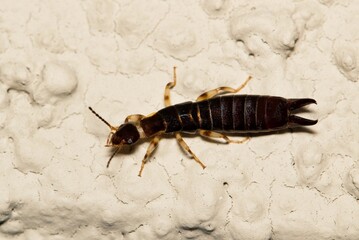Table of Contents
Have you ever seen a little bug with rings on its legs scurrying across your kitchen floor? Chances are, it was a ring legged earwig. These small, reddish-brown insects are often mistaken for cockroaches, but they are quite harmless despite their intimidating look.
Ring-legged earwigs are fascinating creatures, and this guide will explore their unique characteristics, behavior, and habits. From the mysteries of their mating rituals to the role they play in the environment, this guide will provide you with an in-depth look at this curious insect.
Along the way, you’ll also find fun facts that show why the ring legged earwig is one of the most interesting bugs around. So if you’re curious about these amazing insects, read on to learn more about the incredible ring-legged earwig!
While these critters aren’t usually a problem for home-owners, RECON Pest Services is here to help if you have a pest problem at home. Servicing the greater Omaha & Lincoln areas, contact us today if you’re having trouble with any common pest.
Overview of the Ring Legged Earwig
The ring legged earwig is a type of insect that is common around the world. It is also commonly known as a wood wart or wheat ear insect. They are found in a range of temperate and tropical areas, including Europe, Asia, Africa, and Australia. These insects are mainly found in forests, meadows, and gardens. They are also common in agricultural fields, particularly in areas where wheat is grown.
This earwig is a large insect, growing up to around 1.5 inches long, named for its distinctive legs, which feature a series of rings that look almost like bracelets. Each of the rings is actually covered with hairs, and these hairs are sensitive to touch. The rings are a deep red-brown color, with the rest of the body being a paler reddish-brown or yellowish-brown in color.
Description
Ring legged earwigs are large, reddish-brown insects with a distinctive leg pattern. Each leg has a series of rings that look almost like bracelets. The insects use their long antennae to feel around, and their eyes are small and underdeveloped. Ring-legged earwigs have pincer-like mandibles at the front of their head that are used for eating and fighting.
The abdomen is long and has three pairs of legs. The first two pairs of legs are very long, while the third pair is very short. The insects use their long legs to jump and run quickly, although they also walk around slowly. The insects have long legs because they feed on the sap of plants.
Behavior and Habits
Ring legged earwigs are nocturnal insects that feed on the sap of plants and can cause damage to crops. They are usually seen on warm, humid nights and are often attracted to bright lights. The insects have a wide variety of behaviors, some of which are unusual even compared to other insects.
For example, during mating, the male earwig becomes trapped in the female’s genitalia, where he remains until he dies. This strange ritual provides extra nourishment for the female. Another strange behavior is the earwig’s urge to walk across a face when a person is sleeping. In fact, the insects are so common that they are sometimes referred to as “face bugs.” They are also sometimes called “whiskey bugs,” as they tend to be attracted to the sugar in alcohol fumes.
Diet and Feeding
Ring legged earwigs are sap-feeding insects that feed on the sap of plants such as wheat and other grains. They are also sometimes attracted to the sap of other plants, including sugary wild fruits like persimmons and cherries. The insects feed at night and are often seen in large groups.
As earwigs are nocturnal, they are usually only seen during the evening. They are attracted to light and can often be found on walls and ceilings near light bulbs. While the insects feed on the sap of plants, they do not usually cause any significant damage to crops or gardens.
Reproduction and Mating
Very little is known about the mating practices of the ring legged earwig, although it is thought that males often mate with multiple females. The female insects lay their eggs in the soil underneath bushes and plants, particularly wheat. After the eggs hatch, the larvae feed on the roots of the plants until they mature.
Ring legged earwigs may spend up to several years as larvae before emerging as adult insects. This long, slow life cycle is one of the reasons why these insects can be a problem in agricultural areas.
Predators and Defenses
While they are sometimes called “face bugs,” ring legged earwigs are not harmful to humans and they do not bite. In fact, they are completely harmless and do not damage crops.
However, they can sometimes be a nuisance in agricultural areas. This is because the insects spend their early lives in the soil, where they feed on the roots of plants. difficult to control with pesticides, as the chemicals usually target insects that feed on leaves and flowers.
Ring legged earwigs do have a few predators, including certain types of birds and frogs, but aren’t specifically sought after for any particular reason.
Fun Facts
The ring legged earwig is such a strange insect that it even has a few urban legends attached to it. One of the most common myths is that the insects will crawl into a person’s ear while they are sleeping and lay eggs inside their brain.
Another myth is that they are attracted to alcohol and will crawl onto a person’s face if they have been drinking. While these myths are not true, they show how unusual these insects really are.
Ring legged earwigs are also known as woodwarts, wheat ear insects, or whiskey bugs.
Role in the Environment
While they can be pests in agricultural areas, ring-legged earwigs are not a significant threat to crops. They are more of a nuisance than a danger and do not cause any significant damage to crops. In the wild, they eat the sap of plants and are often found in areas with large numbers of plants, such as forest and meadows. They are also sometimes found in large numbers near agricultural crops, particularly wheat. They are also sometimes found in buildings, where they are attracted to light.
Conclusion
The ring-legged earwig is a fascinating insect that is common around the world. It lives in a wide variety of habitats and is often found in large numbers around the world. These insects are harmless, but they can be a nuisance in some agricultural instances.
They are named for their distinctive leg pattern, which includes a series of rings that look almost like bracelets. Ring-legged earwigs are fascinating creatures and are definitely one of the most interesting bugs around. For more facts about this creature, check out this article from Insect Identification.





